Both children and adults will love this Frozen-inspired winter sensory bottle DIY filled with swirling blue glitter and silver snowflake confetti to give it the appearance of a blustery snowstorm.
Winter sensory bottles, such as this DIY Sensory bottle inspired by the Disney movie, “Frozen,” are captivating and educational tools for use in classrooms, therapy sessions, and at home. (First published December 11, 2015; this post about making a Frozen-inspired snowstorm sensory bottle is regularly updated and republished to improve the content.) This swirling snowflake sensory bottle is similar to a snow globe because it looks like a wild winter snowstorm filled with flying snowflakes and silver sequins trapped inside. (My daughter thinks Elsa and Anna would love it along with her Frozen-Inspired Olaf crafts.)
DIY winter snowstorm glitter sensory bottles provide a fun and creative activity and a multifaceted educational tool that supports sensory development, learning, and emotional well-being across different age groups. Both children and adults can benefit from their use. Offering this Frozen-inspired snowstorm sensory bottle to children can engage them in sensory play, help develop their motor skills, and serve as an educational aid as a weather bottle. This homemade winter sensory bottle would also be a great party favor or gift for a Frozen-themed birthday party.
The gentle movement of the winter snowstorm inside this Frozen sensory bottle is calming and soothing, which makes it an excellent sensory toy for children who need help with self-regulation. Sensory jars, such as this swirling snowflake glitter bottle, are commonly used for mess-free sensory play, as a self-regulation tool to help calm an overwhelmed child, or as a meditation technique for children. Calm-down sensory bottles work wonders for adults too! For more information about sensory bottles, including several more quick and easy DIY recipes, hop over to look at Calm Down Sensory Bottles 101.
“As the bottle clears, so does the mind.” ~NRK
Related: Glittering Mermaid Tail Sensory Bottle
Winter Snowflake Sensory Bottle Inspired by “Frozen” Movie
This DIY winter snowstorm glitter sensory bottle, inspired by the popular movie “Frozen,” offers a captivating and therapeutic experience for children and adults. The essence of a snowstorm is captured within the bottle as the glitter swirls and floats, mimicking falling snowflakes in a mesmerizing display.
This winter snowflake sensory bottle is made by filling clear, sealable containers with bottled water, clear liquid hand soap, and clear or blue glitter glue to make it look like a snowstorm straight out of the movie “Frozen.” An array of winter-themed items such as glitters and sequins in shades of blue, white, and silver. Snowflake confetti is added to make the viewer feel like they are alongside Anna and Kristoff in the middle of the snowstorm created by Elsa in the first movie as they gaze into it.
What can you use instead of glycerin for sensory bottles?
The clear liquid hand soap and glue recommended in the craft supplies for these gorgeous homemade sensory tools act like glycerin in a winter wonderland snow globe. They both slow down the movement of the snowflakes inside, creating a soothing “snow globe” effect when the bottle is gently shaken, tipped, or inverted upside down. The sparkling silver sequins, blue glitter, and snowflake confetti of various sizes and shapes recommended in the winter snowstorm sensory bottle craft supplies below make this effect even more powerful.
Frozen-Inspired Sensory Bottle Craft Supplies:
Watch the video below, and read through the step-by-step instructions in the next section to make this DIY Frozen-inspired snowstorm sensory bottle before starting this DIY project. Doing so will help you know the steps involved and what to expect, making it much easier to choose the craft supplies of your preference to use to make your winter sensory bottle. (Amazon affiliate links are provided below for your convenience, but can also be found at most hobby and craft stores. Rhythms of Play will earn a small commission at no cost to the consumer if purchases are made using the orange links below.)
- Clear plastic Voss bottles, empty craft bottles, glass mason jars, or any other recycled bottles or jars that will hold water without leaking.
- Teal or blue glitter glue (or clear glue)
- Clear liquid hand soap or dish soap (Dish soap is usually not as thick as hand soap, so you might need more of it if you choose to use it.)
- Snowflake sequins and confetti (Choose at least one of the following snowflake confetti options):
- silver snowflake sequins,
- sparkly snow snowflake confetti mix,
- blue or silver sequins,
- snowflake confetti mix,
- and/or iridescent snowflakes confetti mix.
- Choose one of the following options to add color to the snowstorm sensory bottle:
- blue glitter tempera paint
- turquoise or blue tempera paint,
- blue liquid watercolor paint,
- or blue food coloring.
- Fine turquoise glitter or use a mixture of blue and silver glitter
- Tempered 4-cup liquid glass measuring cup or mixing bowl
- Whisk
- Hot water (boiling distilled water is best)
- Super glue (optional)
- Duct tape (optional)
Related: Soothing Sea Shells Sensory Bottle
How to Make a Frozen-inspired Winter Sensory Bottle with Snowflake Confetti and Glitter
This magical DIY project will bring a touch of Frozen enchantment into your home! Perfect for fans of the beloved Disney movie, the step-by-step instructions below will show you how to create your own Frozen-inspired Winter Sensory Bottle. This delightful craft combines the shimmering beauty of snowflake confetti and sparkling glitter, encapsulating the winter wonderland of Arendelle in a mesmerizing sensory experience.
Related: Rainstick Musical Sensory Bottle
Snowflake DIY Glitter Sensory Bottle DIY Video Tutorial
First, watch the winter sensory bottle DIY video below to learn more about this gorgeous homemade calm-down jar that looks like a snowstorm is raging inside of it. Then scroll down to read the step-by-step instructions before making this DIY sensory bottle inspired by the Movie “Frozen” by Disney.
DIY Snowstorm Glitter Sensory Bottle Recipe and Step-by-Step Directions
Before starting this DIY project, read through the step-by-step instructions to make frozen sensory bottle crafts, so you know what to expect and understand the steps involved in making these winter-themed sensory bottles. We also recommend looking at the tips in Calm Down Sensory Bottles 101 before making your very first DIY sensory bottle.
1. Gather Materials and Tools to make a winter sensory bottle.
- Start by choosing and gathering the craft materials you want to use to make a frozen sensory bottle from the supply list above.
2. Add hot water, glue, blue paint (or food coloring), and fine glitter to a quart measuring cup and mix well with a whisk.
- First, add hot water (boiling is best) and a good squeeze (about 1 or 2 tablespoons) of clear, turquoise, or blue glitter glue into a 4-cup liquid glass measuring cup.
- Mix the hot water and glue with a whisk before adding the glitter, paint, and the next sensory bottle recipe ingredients.
- Next, add a squirt of blue or turquoise glitter paint, blue tempura paint, blue or turquoise liquid watercolors, or a few drops of blue food coloring. (Choose one of these craft supply options to add a bit of color to your winter discovery jar or calm-down jar.)
- Finally, sprinkle a small amount of fine turquoise glitter (or use a mixture of blue and silver glitter) into the frozen DIY sensory bottle mixture and again use a whisk to mix well. (The amount of glitter you use will determine the opacity or transparency of the winter snowflake sensory bottle.)
- Please note: Cold water is really hard to mix with glue. We recommend using boiling water because it makes it much easier to mix the glitter glue with the water. However, using boiling water also makes it necessary to use a large tempered glass measuring cup as the mixing bowl. Please do not put boiling water directly into the clear plastic bottle or it can warp and melt. Instead, mix the hot water and glue in a tempered 4-cup glass measuring cup and allow it to cool a bit before pouring it into the clear plastic bottle or glass mason jar. (If you use a tempered glass mason jar to make your winter sensory bottle, you can pour the boiling water directly into it to mix the glue, water, and other sensory bottle ingredients.)
3. Once the water has cooled, mix and quickly pour snowstorm sensory bottle ingredients into a clear plastic bottle or glass jar.
- First, allow the winter sensory bottle mixture to cool so that it won’t warp or melt the plastic bottle (or shatter the untempered glass mason jar) when you pour the hot water mixed with the Frozen-inspired snowstorm discovery bottle ingredients into it.
- You will notice that the sensory bottle recipe ingredients will sink to the bottom of the measuring cup as it cools. Use a whisk to remix the ingredients, and quickly pour the mixture into a recycled bottle once it is cool enough.
- Don’t pour the water, glue, and glitter mixture to the top just yet. There are a few more snowstorm sensory bottle recipe ingredients you can add, and you may decide that you need to add a bit more glue, glitter, or paint based on how slow or fast the mixture inside the bottle is moving.
4. Drop pieces of snowflake confetti into the snowy day sensory bottle.
- Next, add the snowflake confetti by dropping it directly into the sensory bottle.
- We used blue sequins (which we don’t recommend) and silver snowflake confetti sequins to make the winter snowstorm sensory bottle shown in the photographs. However several different options are listed in the sensory bottle craft materials above.
5. Mix a little clear hand soap into the Frozen Sensory Bottle if needed.
- Add approximately 1/8-1/4 cup of clear liquid hand soap to the snowflake sensory bottle mixture once the water is completely cool (optional).
- Alternatively, you can substitute clear liquid dish soap, but you might need to use a bit more of it because it is often less viscous than hand soap.
- This recommended ingredient works to help slow the movement of the snowflake sensory bottle DIY mixture even more (so the larger snowflakes will swirl and float for a bit instead of sinking immediately to the bottom of the bottle) and helps increase the calming effect.
- Please note: The soap will get bubbly and frothy if the water is too hot when you add the soap to the sensory bottle mixture. This makes it necessary to allow the water to cool before adding it.
6. Consider adding more of the primary ingredients to speed up or slow down the swirling snowflakes (optional).
- Determine if you need more water, clear liquid hand soap, glue, glitter, paint, or liquid food coloring added to the Frozen-inspired snowstorm calm-down jar.
- Pour a little bit of the sensory bottle solution out to make room for more of this or that if needed, and follow the directions below:
- More water will make it move faster, while more glue or hand soap will make the snowflake sensory bottle mixture move slower.
- Adding more glitter will make the snowstorm sensory bottle look more opaque and less transparent.
- Pouring more paint or food coloring will deepen or darken the color of the winter snowstorm inside the sensory bottle.
7. Top off the Winter Snowstorm sensory bottle with water, glue, or hand soap.
- Pour bottled water, clear or glitter glue, or liquid hand soap into the snowstorm sensory bottle until the glittery snowstorm mixture reaches the top of the bottle and begins to overflow.
- As a reminder, if you want the snowflake-discovery bottle mixture to move faster, add more water. If you want the calm down jar recipe ingredients to move slower, add more clear liquid hand soap, clear glue, or glitter glue into the mix.
- Next, put the lid on, and give it a good shake once the sensory bottle recipe mixture inside is completely cool. Otherwise, it can become bubbly and frothy.
8. Glue the lid of the calm-down jar shut, and secure it with duct tape. (optional)
- Once you are happy with how your Frozen-inspired snowstorm sensory bottle moves and flows, put a drop or two of super glue on the cap, and screw the cap onto the bottle to glue it shut.
- Next, pass it over to the kiddos. Unless you are keeping it for yourself, of course. 😉
- The glue and duct tape will both help ensure kids don’t open the bottle to drink it or pour the contents all over the house (or classroom), but it is optional.
- We choose not to glue our DIY sensory bottles shut because everyone in our household knows how to handle them safely. Scroll down to find out why we don’t glue the lid on.
Related: Rainbow Galaxy Glitter Sensory Bottle
Snowstorm Glitter Sensory Bottle DIY Tips and Troubleshooting
- Don’t glue the lid onto this Frozen-inspired sensory bottle right away. It’s hard to make changes after the cap is glued on.
- Because we used large snowflake confetti for this Frozen-inspired DIY calm-down bottle, we soon learned that we needed to make the solution more viscous so the snowflakes would float and swirl instead of sink right to the bottom. So we added about an 1/8 cup of clear liquid hand soap into the mixture. It worked wonderfully!
- Allow mixture to cool before shaking it to minimize soapy bubbles and froth.
- If bubbles form at the top of the snowflake sensory bottle, first allow it to sit and settle for a few hours.
- If there are still bubbles left after has had time to settle, slowly fill the bottle with hot water and allow the bubbles to flow over the side until no bubbles are left in the sensory bottle DIY.
- If we were to make this DIY glitter sensory bottle again, we would avoid painted sequins and use only snowflake confetti instead. The paint chips off colored sequins, which didn’t matter for this bottle because they added more blue glittery color to the mix. We recommend using only silver sequins if you don’t want this to happen.
- Another potential problem with sequins is that they tend to stick to the side of the snowstorm sensory jar rather than swirl. Use your discretion if you choose to include them in your Frozen-inspired snowflake sensory bottle.
Why do we Choose Not to glue our sensory bottles Shut?
We have noticed that after DIY sensory bottles have been made and allowed to sit for a while the bottle will begin to suck in and create an indent. Not gluing the lid onto the bottle makes it possible to open the bottle to allow air back into it to remove the dent.
But please use caution if you choose not to glue your DIY sensory bottle shut. Also, be very mindful if you ever open your homemade snowflake discovery bottle or calm-down jar. They can spill and make a terrible glittery mess if the proper care is not taken. Open them over a sink, bathtub, or bucket just in case!
Educational and Developmental Benefits of DIY Winter Sensory Bottles
These sensory bottles serve multiple educational and developmental purposes for toddlers, preschoolers, and school-aged children. Not only are these winter sensory bottles visually appealing, but they also serve an important purpose in child development. Here’s a list of several ways they can benefit child development and act as an educational aid:
- Mess-fee and safe sensory play activity: Babies, toddlers, preschoolers, kindergarteners, and young elementary school-aged children can investigate the contents and actions or inner workings within this winter sensory bottle without making a mess or touching hazardous objects directly. This makes DIY sensory bottles an excellent resource for sensory exploration, as children engage their visual and tactile senses while observing and handling the bottle.
- Strengthen fine motor skills: Winter calm-down jars like this one help develop fine motor skills as children grasp and manipulate the bottle, and this interaction aids in developing hand-eye coordination.
- Calming and soothing an overwhelmed or anxious child: Believe it or not, this snowstorm can be calming and particularly beneficial for children who experience sensory overload or struggle with strong emotions and self-regulation. The slow, graceful movement of the glitter can be soothing and helps foster focus and relaxation. (Practicing yoga is another great calming strategy for kids. Learn how to get kids started, or look at our favorite FREE yoga videos for kids.)
- Imaginative open-ended play: The “Frozen” theme adds a layer of engagement, especially for kids that are fans of the movie. It can spark creative storytelling and encourage open-ended dramatic or imaginative play that can enhance language and cognitive skills.
- DIY Weather sensory bottle for winter: The swirling snowflake snowstorm inside this winter sensory bottle makes it perfect for use as an educational aid. See how below.
Winter Weather Sensory Bottle DIY
This winter snowstorm bottle also acts as a weather sensory bottle that offers an opportunity to educate children about snowflakes, snow storms, weather patterns, and similar winter weather phenomena in an interactive way.
Winter sensory bottles, such as this winter snowstorm weather bottle filled with swirling snowflakes and blue glitter that looks like snow and ice, can be a useful educational tool to teach about the winter season, weather patterns, and the concept of snow.
For younger children, it can be a tool to introduce basic weather concepts like snowflakes, snow, and storms. At the same time, for older kids, it can be a starting point for discussions about meteorology, the science behind snowstorms, the symmetry of snowflakes, and more!
Related: Beaded Snowflake Ornaments
Frozen-Inspired Snowflake Snowstorm Sensory Jar
Ideal for kids and adults who love a bit of whimsy, this sensory bottle is a beautiful decorative piece and a calming tool that can help soothe and captivate. Making it a fun mess-free DIY calm-down toy for kids.
Think of it the same way as a giant snow globe craft that can help toddlers, preschoolers, kindergarteners, and elementary-aged kids learn how to calm down and learn to self-regulate. Focusing on the objects in this Frozen-inspired DIY glitter sensory bottle filled with sparkling snowflake confetti can help children and adults calm down and focus.
Gather the materials from the list of winter sensory bottle craft supplies above and embark on this enchanting snowstorm sensory bottle crafting adventure! We hope you love this calming tool as much as we do. You might also enjoy these winter art projects and painting ideas, and this list of fun winter activities with a printable bucket list for kids and adults.
Learn more about Rhythms of Play HERE!
More DIY Glitter Sensory Bottles:
- Rainbow Galaxy Sensory Bottle
- Sunburst Glitter Sensory Bottle DIY
- Glittering Mermaid Tail Calming Sensory Bottle

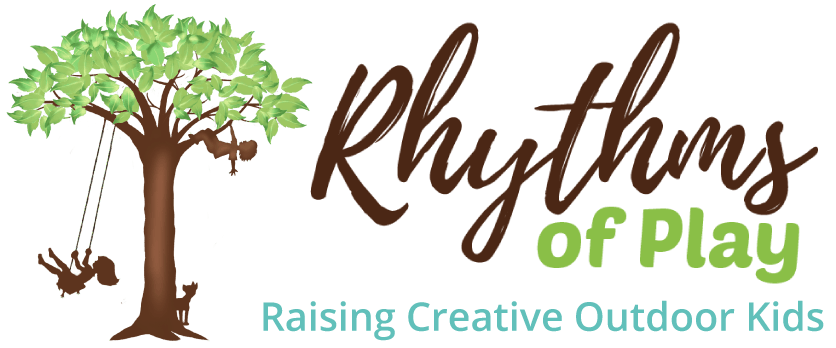
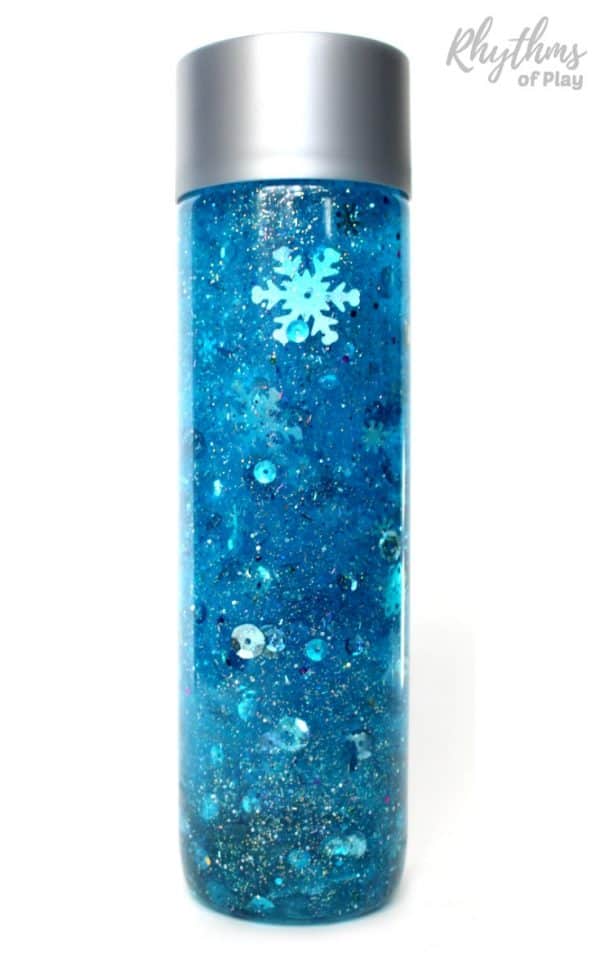
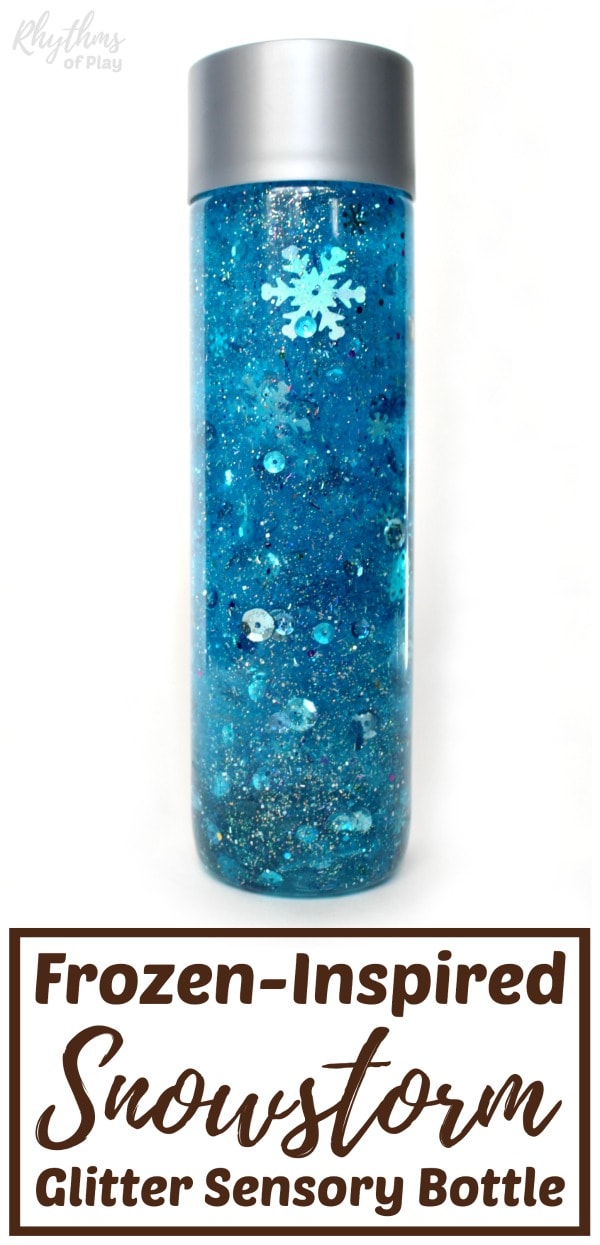
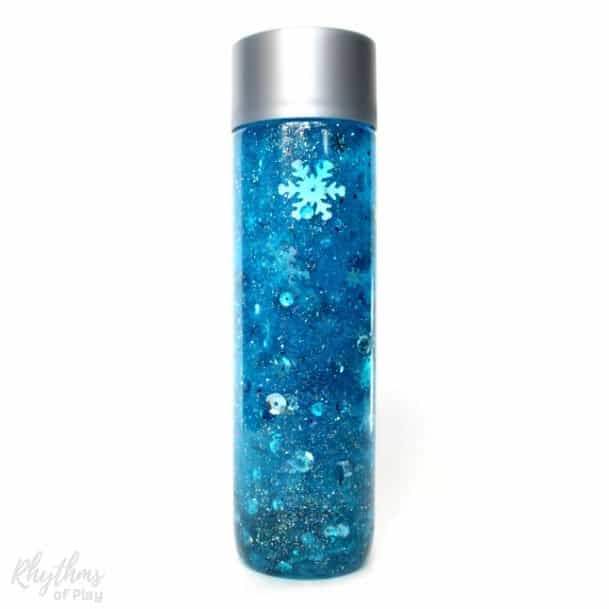

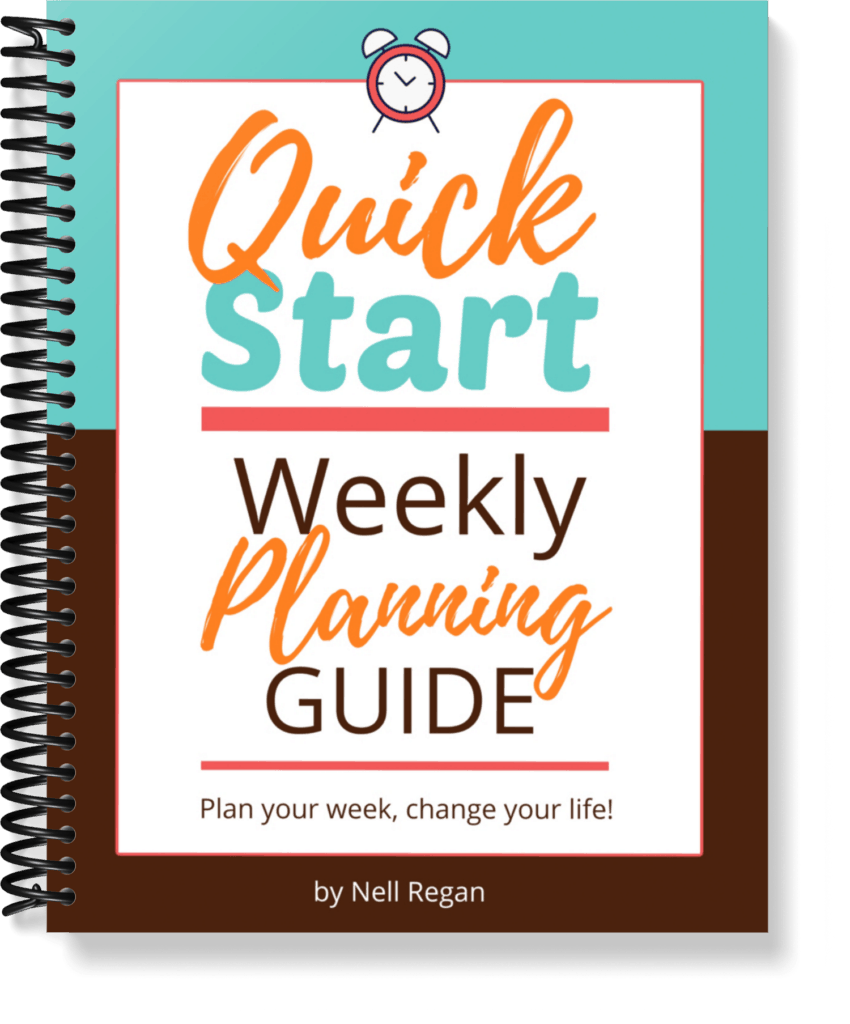
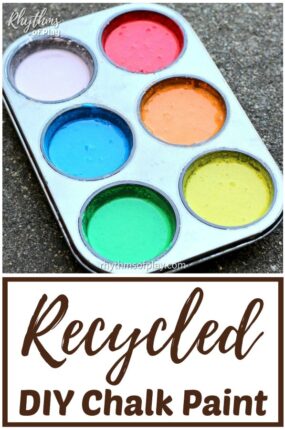
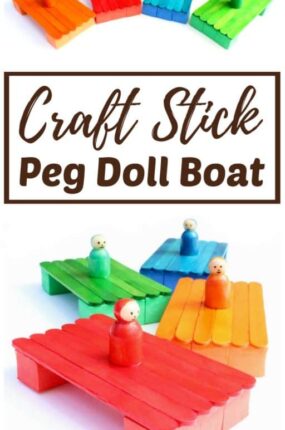
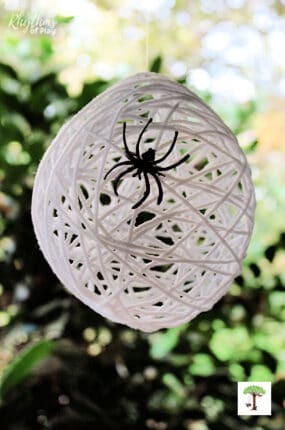
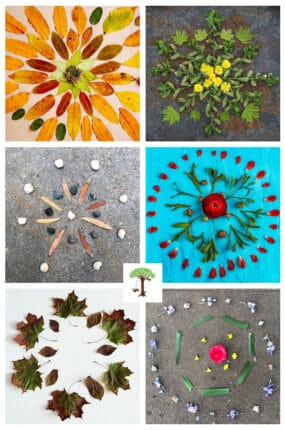
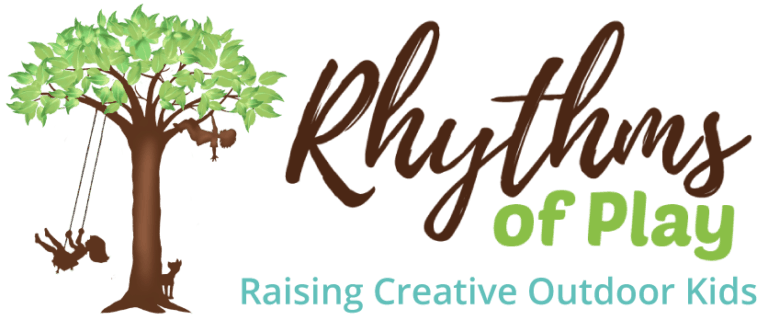
How did you keep yours from getting foamy?
Hi Ashley! My bottles are always foamy when I first make them and shake them up. They can take up to a day to settle. Once settled they never foam up again. If yours do, make sure you take all the air out. I hope that helps!
this is beautiful! It looks like it would be cold to touch lol. I’m new to making sensory bottles, but wanted to make one for each season so hopefully mine turns out as gorgeous as this. I can’t wait to see it in motion
Lol! It does look cold to the touch Kaci, so glad you like it! Sending you all my sensory bottle making ju-ju so it’s just as awesome!
I made some for my 3 year old preschool class who are pretty rough on the bottles. They managed to actually break the caps on the Voss bottles!! Is there something I did wrong?
No Jennifer, You did nothing wrong. Voss bottles can break if thrown around or dropped. This is the only con I have found with them.
Use duct tape or electrical tape on the lid. It helps.
Brilliant solution Kasey! Thank you for sharing 🙂
This is my first attempt at a sensory bottle! I used a bottle that I had at home, but I had trouble adding some items to the solution, because the opening was small. How large is the opening for the VOSS bottles? And what size bottle do you use? The 330 ml size? I thought of adding buttons that I bought for the bottle, but a few of the buttons wouldn’t fit into the opening. I hope I can find the items you suggested for the Frozen bottle!!
So glad you are giving it a try Patty! This bottle is actually one of the most challenging of my bottles to make, but it was my first too 🙂 I use the 500ml Voss bottles. They have a larger opening than most bottles at almost an inch and 1/2 diameter. This is another reason I like to use them. You can easily fit fun items in them like the larger snowflakes. I think you can probably bend the snowflakes just a bit to get them inside bottles with smaller openings. They are flexible but will stay permanently bent if folded too far. Good luck!
Hi I am new to making these but I wanted to make one for my grandson I have all the ingredients in and gave it a shake but everything just went straight to the bottom. So I poured out some water and added more soap and it still will not float just straight to the bottom like rocks! What did I do wrong? Help!
Hello, I’m so sorry it did not come out as you expected. Did you heat the water and mix it with the glue before adding the other ingredients? It won’t work if everything is added all at once.
Hi. I’m planning on making these with kids. I was trying to figure out for how many kids the materials you listed are. Do you have any suggestions?
Besides the bottles and doing the math on the liquids you will need, the rest should be enough? A little glitter goes a long way!
What are your pro/con comments on plastic water bottles?
Sorry for delayed response Rebecca. This is a loaded question for me and why we prefer to use bottles from the recycle bin. We get ours from the recycle bin at my husband’s work because we choose not to purchase plastics. At home, we filter our own water and use reusable stainless steel canteens for our water. Using mason jars to make sensory bottles is another option, but as you know glass can be dangerous if broken!
I like your Frozen sensory bottle much better than Amazon’s.
Thanks for the vote of approval, Pam! We always appreciate hearing when people love our sensory bottles. <3
Will any clear gel hand soap work? I am not finding the particular one listed. Just curious if it makes a difference.
Hi Laura. Any clear gel hand soap should work, yes. The one you use may have slightly different viscosity, so you may need a bit more, or a bit less than mentioned. Good luck!
Can we use blue food coloring instead of tempera paint? Since that’s what we have on hand.
Great question, Pricilla!
Yes, blue food coloring would work perfectly. Put a drop or two in and see if you like the color and add more if needed!